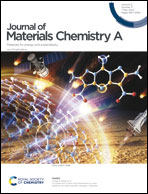Enhancing photocatalytic CO2 reduction via a single-domain ferroelectric Z-scheme heterojunction of BiFeO3/CsPbBr3 inducing dual built-in electric fields†
Abstract
Utilizing the inherent spontaneous polarization of single-domain ferroelectric materials is crucial for achieving spatial charge separation via the induction of a built-in electric field. Herein, a single-domain Z-scheme heterojunction of BiFeO3/CsPbBr3 was rationally designed by in situ growth of CsPbBr3 nanocrystals on the surface of single-domain BiFeO3 nanosheets. Detailed experimental characterization and theoretical simulations reveal that forming the single-domain BiFeO3/CsPbBr3 heterojunction induces a polarization electric field within the BiFeO3 and a built-in-electric field at the heterojunction interface, both of which act as dual driving forces (DDFs) for charge separation. Under light irradiation, the DDFs enable significant spatial charge separation within the heterojunction following a Z-scheme charge transfer mode. Consequently, the single-domain BiFeO3/CsPbBr3 heterojunction yields a sound photocatalytic CO production rate of 53.1 μmol g−1 h−1 in a solid–vapor reaction system under visible light irradiation, representing a 6.4-fold increase in activity compared to pristine CsPbBr3. This work demonstrates the significant impact of developing single-domain heterojunction photocatalysts to enhance visible light-driven photocatalytic systems.



 Please wait while we load your content...
Please wait while we load your content...